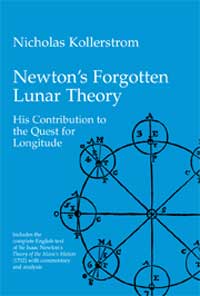Newton’s Forgotten Lunar Theory
His Contribution to the Quest for Longitude
By Nicholas Kollerstrom
6" x 9", 278 pages, diagrams and tables, index and bibliography
Publication date 2000.
For pricing and ordering information, see the ordering section below.
 Newton's 1702 lunar theory has puzzled scholars for centuries. Was it based on gravitational theory, as the anonymous prefatory matter suggests? If so, why did it make use of epicycles — the last serious astronomical work to do so? How did its various parameters fit together? How accurate was it? How was it related to Newton's lunar theory in the 1713 edition of the Principia? Did anyone actually use it?
Newton's 1702 lunar theory has puzzled scholars for centuries. Was it based on gravitational theory, as the anonymous prefatory matter suggests? If so, why did it make use of epicycles — the last serious astronomical work to do so? How did its various parameters fit together? How accurate was it? How was it related to Newton's lunar theory in the 1713 edition of the Principia? Did anyone actually use it?
In this engaging piece of detective work, Nicholas Kollerstrom has combined historical research with computer analysis to investigate these questions. The lunar theory turns out to have been the basis for numerous eighteenth century tables, and was used in China well into the twentieth century. It was taken (heavily disguised) into the Principia of 1713, with one important correction. In this form, it was remarkably accurate, about as good as the observations on which it was based, and was used by Halley (in a procedure explained here for the first time) to compute lunar positions with an accuracy of under one arcminute — good enough to have won the longitude prize.
Newton's Forgotten Lunar Theory breaks new ground in history of science, showing how desktop computers can be used to recreate both the conditions of ancient skies and the working of early astronomical theories, to an accuracy better than that which was available to the historical characters. This lets us see how well the theories actually worked, and provides valuable insight into the evolution of astronomical theories and their parameters. Although the present text can be profitably read without using a computer, it can be used to even more advantage in conjunction with Kollerstrom's computer model, which can be freely downloaded from the Web.
Newton's Forgotten Lunar Theory includes the complete text of the 1702 English edition of Newton's Theory of the Moon's Motion, with annotations and a detailed commentary, and numerous tables and graphs showing the results of computer analysis.
More information about this can be found on Nicholas Kollerstrom's "Newton and the Moon" web site from the Green Lion Press Links page.
Features
- Includes the complete English text of Newton's Theory of the Moon's Motion (1702).
- Combines historical research with computer analysis.
- Shows Newton's use of the ancient Greek device, the epicycle
- Through analysis of published works up to about 1750, shows that all were using Newton's model, sometimes with modifications.
- Concludes with Edmund Halley's brilliant extension of Newton's theory, attaining a level of accuracy that would have won the Longitude Prize, had Halley survived.
Reviews
Newton's Forgotten Lunar Theory is an exceptionally clear, well-written study of Isaac Newton's 1702 Theory of the Moon's Motion. As Nicholas Kollerstom shows, the theory influenced a large number of the most prominent astronomers of the eighteenth century, including Edmond Halley. Kollerstrom contends that, with Halley's corrections, the theory was good enough to have won the coveted Longitude Prize, instituted in 1714.
This book is best suited for historians of science, though scientists and philosophers of science would certainly enjoy it. It begins by presenting the 1702 English edition of Newton's lunar theory, which is supplemented with detailed commentary. This, I believe, is an excellent feature of the book. Kollerstrom pulls no punches, allowing the reader to get a sense of the challenge he is willing to take on. ... Kollerstrom does an excellent job in telling the story of Newton's forgotten lunar theory.
— Kurt Smith
from the Isis Review, September 2005
(Isis is the journal of the History of Science Society, published by the University of Chicago Press).
To read the full review as a PDF file, click full Isis NFLT Review.
Kollerstrom has resolved important and hitherto unresolved puzzles concerning Newton's lunar theory. He corrects the errors of prior historians with respect to it. He provides measures of its accuracy and influence more detailed and accurate than anything available previously. These are decisive advances on which future researchers can rely.
— Curtis Wilson
Editor, General History of Astronomy
Nicholas Kollerstrom's computer-assisted analysis, Newton's Forgotten Lunar Theory, is definitive. Kollerstrom judges the method, as employed by Halley, as accurate enough to have won a £10,000 prize established by Parliament in 1714.
— James Gleick
from his book, Isaac Newton
